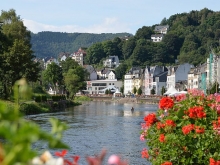
Melgaço
The municipality of Melgaço, integrates the NUTSIII_COD111 Minho-Lima unit, regional district of Viana do Castelo, in the region of northern Portugal. The municipal territory has an approximate area of 238.25 km2 and about 10.000 inhabitants. The municipality is limited to the north and east, by Galicia / Spain, to the southwest by the municipality of Arcos de Valdevez, and to the west by the municipality of Monção. Presently the municipality employs around 300 public servants and politically is governed by a full-time mayor and 6 other elected politicians forming the executive body -“Câmara Municipal”. These politicians, in turn, manage a budget approved by the city council, which consists of 34 elected deputies, 13 of them are the elected representatives of the parishes.
The main urban center of the Municipality is known as “Vila de Melgaço”, and comprehends the parishes of Vila and Roussas with a resident population of about 3000 inhabitants.
Tourism is nowadays the mainstay of the economy, assuming up to 58% of local economic activity of Melgaço. Remaining major activities are agriculture, in particular, winemaking, as well as the health sector, financial and other services. Data collected from entrances in public places point to 20,000 annual visitors coming into Melgaço but main events, including the annual wine festivals and an international film festival, attracts more than 60,000 visitors on their own.
A major part of Portugal’s only national park, which is also a UNESCO registered GeoPark, is located in the administrative area of Melgaço. The national park assures outstanding environmental and landscape features to the Melgaço´s territory providing the settings for a comprehensive offer of leisure activities, ranging from rock climbing and hang gliding to fishing, canoeing, rafting, and hiking or mountain bike. The town of Melgaço offers a mixture of ancient and modern attractions. Many of the important historic buildings are municipal property, therefore maintained to a high standard of conservation and use. The medieval castle and walls, still show his medieval surrounding core of residential dwellings, where we can find the museum of cinema, hosting the private collection of Jean-Loup Passek.
Since the early ’90s, the municipality of Melgaço (like many of Portuguese interior municipalities) has been losing population. Either from lack of births or due to emigration (internal or transnational), all the parishes of the territory verified a significant loss of residents, exception made to Melgaço city center who concentrates around 30% of the overall population, that verified an increase of 13%.
Also, the general aging of the population presents worrying notes. The aging index between 2001 and 2011, which affects the ratio between the elderly population (number of people aged 65 and over) and the young population (number of people aged 0-14), is presently negative taken that in 2011 there were approximately two (2) persons aged 65 or over for each child under the age of 15.
However, the urban center of Melgaço shows a notorious concentration of economic activities and public services, polarised by the tourist dynamics of the territory of Melgaço in the context of the North of Portugal and Galicia. Melgaço stands out on his historical and artistic heritage (in particular the historical core of the town) and the importance of its local products, namely the famous Alvarinho wine, providing a wide range of assets and values to consider for the dynamics of urban revitalization and social cohesion.
SOME RELATED NETWORKS
Re-growCity
News
News from our networks – 26 February 2021
Article




